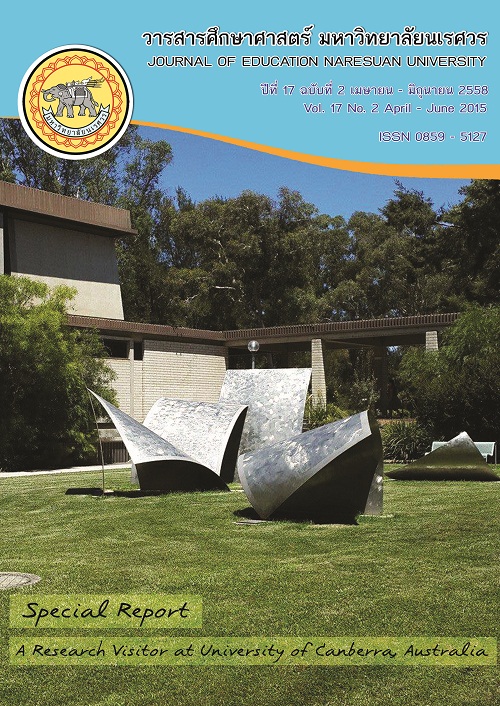Learning Style Preference and Instructional Strategy for Enhancing Potential of ASEAN Graduate Students in Thai Higher Education
Main Article Content
Abstract
Abstract
This research aimed to 1) find out the dominant learning style preferences of ASEAN graduate students using for learning in Thai Higher Education, 2) investigate how ASEAN graduate students learn with their dominant learning style preference at Naresuan University, and 3) propose the appropriate instructional strategies for ASEAN graduate students in Thai Higher Education. The study was presented in 3 main steps based on research objectives. Step I, there were totally 225 respondents were selected from all ASEAN graduate students in Thao Ngam Network (Naresuan University, Burapha University, Mahasarakham University, Taksin University and Srinakarinvirot University) who enrolled in the first semester of academic year 2012 and 2013, in master’s degree. The research instrument was learning style preference questionnaire adapted from Peter Honey and Alan Mumford (1992). Step II, There were totally 29 ASEAN graduate students who enrolled in the first semester of academic year 2012 and 2013, in master’s program at Naresuan University. After checking the learning style preference scores among four types of learners, 12 respondents whose learning style as reflectors were selected as participants for interview. Step III, the proposed instructional strategy was done with five main stages as follows: First, it was to identify the characteristics of learning style preference. Second, it was to classify the result of data from respondents as learning strategy. Third, it was to suggest instructional strategy. Fourth, it was to be verified by 5 experts and then the data were analyzed by using statistic as Median and Inter-Quartile Range (IQR) with Standard Criteria: Median > 3.51, IQR< 1.50 to be consensus. Fifth, it was to modify suggested instructional strategy.
The findings summarized as follows:
1. The dominant learning style preference among ASEAN graduate students was categorized as four types of learning style preferences, Activist, Reflector, Theorist and Pragmatist. From the total number 225 ASEAN graduate students, the researcher received 74.66% of respondents. So there were 168 respondents replying to questionnaire. The result from data analyzing showed that the majority of learners was Reflectors (39%) and followed by Pragmatist (25%), Activist (20.83%) and Theorist (14.88%). From 66 reflectors among 5 Universities, there were 12 respondents whose learning styles were reflectors at Naresuan University, so they were selected as the participants for interview in the next step of study.
2. After 12 reflectors were interviewed about how to learn, The result was classified into key attributes as 1) being ready and well-prepared 2) being thoughtful 3) being cautious 4) being a good listener and making an observation 5) being thorough and methodical 6) making a conclusion. The data were learning strategies of ASEAN graduate students in Thai Higher Education which would be used to propose appropriate instructional strategy.
3. The suggested strategies were proposed from learners’ learning style preferences and learning strategies which there were 36 items within 9 steps of instruction. The result of data analysis showed that there were 35 items which were consensus and another item was non-consensus, since it was higher than the criteria (IQR=1.96). Eventually, those suggested strategies were modified as ASEAN strategy: (A= Attraction, S= Stimulation, E= Engagement, A=Assessment, N= Notation) along with process of activities in each step.
Key words: Learning Style/ Instructional Strategy/ ASEAN graduate student/ Higher Education
Article Details
The owner of the article does not copy or violate any of its copyright. If any copyright infringement occurs or prosecution, in any case, the Editorial Board is not involved in all the rights to the owner of the article to be performed.


